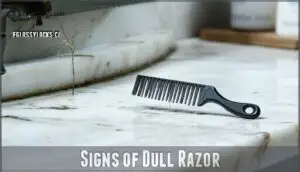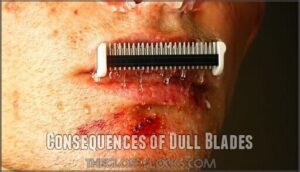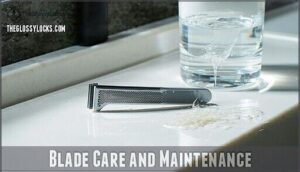This site is supported by our readers. We may earn a commission, at no cost to you, if you purchase through links.

Hair thickness plays a major role—coarse hair dulls blades 40% faster than fine hair, while dense hair reduces longevity by up to 50%.
Watch for telltale signs like tugging, increased pressure requirements, or that dreaded razor drag that turns your morning routine into a chore.
Dull blades don’t just give you a patchy shave; they increase your risk of cuts, razor burn, and even bacterial infections from microscopic skin tears.
Proper blade care extends lifespan substantially through thorough rinsing and complete air-drying between uses.
Table Of Contents
- Key Takeaways
- Razor Blade Replacement
- How Often Replace Razor
- Factors Affecting Longevity
- Signs of Dull Razor
- Consequences of Dull Blades
- Blade Care and Maintenance
- Choosing Right Razor Blade
- Shaving Techniques Matter
- Health Risks and Hygiene
- Replacement Frequency Guidelines
- Frequently Asked Questions (FAQs)
- What happens if you don’t change your razor blade often?
- How often to change razor blades?
- How often should you replace a safety razor?
- How often should a shave blade be replaced?
- How do you know if it’s time to change your razor blades?
- What are signs it’s time for a new razor?
- How often should you change your razor blade?
- Do you need to change your razor after 10 shaves?
- How often should razor blades be replaced?
- How to tell if a razor blade is dull?
- Conclusion
Key Takeaways
- Replace your razor blades every 5-7 shaves or weekly if you’re shaving daily to maintain peak performance and prevent skin irritation.
- Watch for warning signs like tugging, increased pressure needs, or razor drag – these indicate it’s time for a fresh blade regardless of usage count.
- Your hair type affects replacement frequency – coarse, thick hair dulls blades 40% faster than fine hair, requiring more frequent changes every 3-4 shaves.
- Proper blade care extends lifespan through thorough rinsing and complete air-drying between uses, but don’t push dull blades as they increase the risk of cuts and bacterial infections.
Razor Blade Replacement
Most razor blades need replacement every five to seven shaves, though this depends on your hair type and shaving habits.
You’ll know it’s time when your razor starts tugging at hair instead of cutting smoothly through it.
General Guidelines
Most experts agree that understanding proper razor blade replacement isn’t rocket science, but it’s vital for maintaining superior shaving performance and skin health.
Here are the essential razor blade replacement guidelines:
- Change blades every 5-7 shaves for ideal razor blade sharpness and performance
- Replace weekly for daily shavers to maintain consistent blade longevity and comfort
- Monitor blade quality – high-end razors last longer than disposables
- Adjust replacement tips based on your individual shaving frequency and hair type
- Prioritize razor maintenance through proper cleaning and storage between uses
Frequency of Replacement
Your shave frequency directly determines how often you’ll need fresh blades.
Daily shavers should swap cartridges every 1-2 weeks, while those shaving every other day can stretch replacement to 2-3 weeks.
Twice-weekly shavers typically get 4-6 weeks from quality blades.
| Shaving Schedule | Replacement Timeline | Blade Lifespan |
|---|---|---|
| Daily | 1-2 weeks | 5-7 shaves |
| Every other day | 2-3 weeks | 10-14 shaves |
| Twice weekly | 4-6 weeks | 15-20 shaves |
Hair density affects these replacement schedules substantially—coarser beards wear down edges faster than fine hair.
Signs of Dull Blades
Knowing when to replace your razor isn’t just about counting shaves—your skin tells the story.
Watch for these telltale signs that indicate blade dullness and compromised razor blade sharpness:
- Razor drag and tugging sensation instead of smooth gliding
- Skin irritation with redness, bumps, or burning after shaving
- Patchy shave requiring multiple passes over the same area
- Blade rust or visible buildup between razor edges
These warning signs signal it’s time to replace razor blades for ideal razor blade longevity and performance.
How Often Replace Razor
Your replacement schedule depends on how often you pick up that razor.
Daily shavers need fresh blades every week, while occasional groomers can stretch theirs to a month.
It’s not rocket science, but getting it wrong means trading smooth skin for irritation.
Here’s your razor blade replacement roadmap:
- Daily shavers: Replace blades every 5-7 shaves (1-2 weeks)
- Every-other-day users: Change blades every 10-14 shaves (2-3 weeks)
- Twice-weekly shavers: Swap blades every 8-12 shaves (4-6 weeks)
- Cartridge razors: Follow manufacturer guidelines of 10-20 shaves
- Safety razors: Replace single blades every 3-7 shaves
Your shave frequency guide isn’t just about counting uses—it’s about maintaining razor blade sharpness and proper razor hygiene.
Think of blade replacement schedules like changing your car’s oil: skip it, and you’ll pay later.
Quality razor maintenance keeps your skin happy and your morning routine smooth.
Regular razor blade maintenance is vital for extending the life of your razor blades.
Factors Affecting Longevity
Understanding what affects how long your razor blades stay sharp can save you money and prevent irritating shaves.
Several key factors determine whether you’ll be changing blades weekly or stretching them longer.
Hair Thickness and Density
Your beard’s texture acts like sandpaper against blade edges.
Coarse Hair causes 40% faster dulling, while Hair Density increases friction, reducing Blade Longevity by 25-50%.
Thick, dense beards require replacement every 3-4 shaves versus 8 for fine hair.
| Hair Type | Replacement Frequency | Blade Wear Rate |
|---|---|---|
| Fine/Sparse | 7-8 shaves | Standard |
| Medium/Moderate | 5-6 shaves | 25% faster |
| Thick/Dense | 3-4 shaves | 40-50% faster |
| Very Coarse/Dense | 2-3 shaves | 75% faster |
The table summarizes the relationship between Hair Type and Blade Wear Rate, providing a clear guide for maintenance based on individual beard characteristics.
Shaving Surface Area
Your shaving surface area directly impacts razor blade replacement frequency and blade longevity.
Larger areas like full-face shaves or head shaving demand more from each blade, requiring frequent replacement.
Extensive shaving surface area increases hair length contact, affecting blade angle efficiency.
Consider your skin type and shave size when determining shaving frequency—more coverage means shorter razor blade lifespan and earlier blade replacement needs.
Blade Quality and Material
Your blade’s material determines how long it’ll serve you well.
Stainless steel offers superior corrosion resistance and edge retention compared to carbon steel, which dulls faster despite initial sharpness.
Coating technology like titanium nitride can extend blade durability up to 2.5 times longer.
High-quality steel maintains razor blade performance through multiple shaves, while cheaper materials compromise longevity and comfort.
The choice of steel material types substantially affects the overall shaving experience.
Shaving Frequency and Technique
Your daily habits dramatically shape your razor blade replacement schedule and overall shave quality.
Frequent shavers need more regular blade changes, while proper technique extends blade life substantially.
- Daily shavers: Replace blades every 5-7 uses or weekly
- Every-other-day routine: Change blades every 2-3 weeks
- Twice weekly: Replace every 4-6 weeks
- Poor technique accelerates dulling: Excess pressure and wrong angles damage blades faster
Signs of Dull Razor
Recognizing when your razor blade has lost its edge can save your skin from unnecessary irritation and guarantee a consistently smooth shave.
You’ll know it’s time for a replacement when your razor starts tugging at hair instead of cutting cleanly through it, or when you notice increased redness and bumps after shaving, which can be a clear sign that the blade has lost its edge.
Tugging and Pulling
When your razor starts fighting back with Razor Drag and Hair Pull, it’s sending a clear message.
A sharp blade cuts cleanly—dull ones tear and drag like sandpaper
A sharp blade glides effortlessly, but blade dullness creates Shave Resistance that makes every stroke feel like a battle against Skin Tug and Blade Catch.
Here are four telltale signs of razor blade sharpness decline:
- Increased pressure needed – You’re pushing harder to achieve the same results
- Multiple passes required – Areas need repeated attention for smooth results
- Hair gets caught – Follicles bend rather than cut cleanly
- Uncomfortable dragging sensation – The blade scrapes instead of slicing
This tugging indicates your razor blade lifespan has expired, affecting shaving frequency comfort and signaling immediate razor blade replacement needs.
Skin Irritation and Redness
Post-shave skin irritation and redness serve as telltale signs your razor blade has overstayed its welcome.
When blades dull, they create microscopic tears in your skin rather than clean cuts through hair follicles. This trauma triggers inflammatory responses, resulting in razor burn, shaving rash, and angry red bumps.
Your skin care routine shouldn’t include damage control from worn blades—timely razor blade replacement prevents these irritation signs completely.
To minimize skin irritation, this is key to understanding the importance of exfoliate to prevent razor burn and take preventive measures to achieve healthy skin.
Patchy Shave and Missed Spots
When your razor blade loses its edge, you’ll notice uneven results across your face.
A patchy shave with missed spots indicates declining blade efficiency and compromised razor sharpness.
Your hair texture plays a role—coarse hair reveals dull blades faster than fine hair.
Poor shave quality forces multiple passes, increasing irritation risk.
This inconsistent performance signals it’s time for razor blade replacement, regardless of your shaving frequency guide or technique.
Visible Buildup and Rust
When you spot soap scum, hair, and dead skin cells clogging the razor head, it’s time for replacement.
This visible buildup clogs blade edges and accelerates rust formation on metal surfaces.
Regular rust inspection reveals orange-brown discoloration that compromises razor sharpness and blade corrosion resistance.
Proper buildup removal and rust prevention through immediate post-shave cleaning extends razor blade life, but once metal decay begins, razor blade replacement becomes necessary for effective razor maintenance.
Consequences of Dull Blades
Using a dull razor blade creates a cascade of skin problems that go far beyond a simple bad shave.
You’ll face increased risks of razor burn, ingrown hairs, bacterial infections, and persistent skin irritation that can take days to heal, including persistent skin irritation.
Ingrown Hairs and Razor Burn
Dull blades create a perfect storm for skin inflammation.
Sharp blades cut cleanly—dull ones tear skin and create irritation nightmares.
When you shave with worn razors, you’re basically dragging metal across delicate hair follicles, triggering razor bumps and irritation.
Clinical studies show dull blades increase ingrown hair risk by forcing multiple passes over the same area.
Proper shaving techniques can help minimize these issues.
Key consequences include:
- Razor burn from excessive friction – requiring more pressure and repeated strokes
- Ingrown hairs affecting 60% of curly-haired individuals – particularly problematic for coarse hair types
- Skin inflammation requiring proper shave preparation – emphasizing exfoliation techniques and razor blade replacement timing
Following shaving frequency recommendations prevents these issues entirely.
Bacterial Infections and Cuts
Beyond razor burn lies a more serious threat you can’t ignore.
Dull blades create microscopic tears in your skin, opening pathways for bacteria to invade.
These wounds become breeding grounds for skin infections, including folliculitis and cellulitis.
Sharp razor blade replacement prevents bacterial risks by ensuring clean cuts rather than jagged tears.
Proper wound care and cut prevention start with recognizing when razor dullness compromises your skin’s natural barrier against harmful microorganisms, including the risk of cellulitis.
Skin Irritation and Bumps
When your razor blade dulls, it doesn’t just cut poorly—it becomes a skin irritation nightmare.
Dull blades scrape rather than slice, causing razor burn, bumps, and persistent redness.
The blade’s rough edge drags across your skin, triggering inflammatory responses that create those angry red bumps you’re trying to avoid.
Sharp razor blade replacement prevents these skin issues by ensuring clean cuts that minimize trauma to your skin’s surface.
Missed Hairs and Patchy Shaves
When your blade loses its edge, you’ll notice uneven results across your face.
A patchy shave occurs because dull blades can’t slice through hair texture consistently, leaving stubborn patches behind.
This forces you to make multiple passes over the same areas, compromising shave quality and increasing irritation risk.
Poor blade sharpness means your shaving technique becomes less effective, regardless of your skill level.
These missed spots often coincide with skin conditions like razor burn, creating an frustrating cycle that proper razor blade replacement easily prevents.
The proper razor blade replacement is key to avoiding these issues.
Blade Care and Maintenance
Taking care of your razor blades isn’t rocket science, but it’ll save your face and your wallet.
Simple cleaning and proper storage can double your blade’s lifespan while preventing those painful tugs and irritating nicks.
Proper Cleaning and Storage
After each shave, rinse your razor thoroughly under hot water to remove hair and debris.
Shake off excess water, then air-dry completely before storing in a clean, dry location away from humid bathroom conditions.
Never store wet razors in closed containers—this promotes bacterial growth and rust.
Use razor caps for blade protection.
Proper razor sanitizing with rubbing alcohol weekly extends blade longevity and prevents infections.
Avoiding Heat and Friction
Why endure unnecessary razor burn when simple heat control can transform your shaving experience?
Excessive Heat Control and Friction Reduction protect blade integrity while enhancing Skin Protection. Hot water softens hair effectively, but scalding temperatures dull edges prematurely.
Proper Shave Technique involves lukewarm rinses and gentle Blade Cooling between passes.
This razor blade maintenance approach extends razor blade longevity substantially, reducing shaving frequency guidelines for replacement, utilizing Proper Shave Technique is key.
Using High-Quality Blades
Investment in premium materials pays dividends for your skin’s health.
Superior Steel Quality and advanced Blade Coating technologies deliver exceptional Edge Retention that transforms your daily routine.
Consider these performance indicators when selecting razor blade quality:
- Stainless steel construction resists corrosion while maintaining Blade Sharpness longer
- Platinum or polymer coatings reduce friction and enhance Razor Edge durability
- Multiple cutting surfaces distribute wear evenly across the blade
- Precision-engineered angles optimize cutting performance and razor blade longevity
Quality blades reduce razor blade replacement frequency substantially.
Regular Replacement and Inspection
Check up on your blade replacement schedule like clockwork—your skin will thank you for staying consistent.
Inspect each razor before use, looking for rust, nicks, or dull edges that signal it’s time for a swap.
Proper razor maintenance involves understanding blade replacement options to guarantee the best shaving experience.
| Inspection Frequency | What to Check | Replace When |
|---|---|---|
| Before each shave | Rust, nicks, buildup | Visible damage present |
| Weekly assessment | Sharpness, lubrication strip | Tugging or faded strip |
| After 5-7 uses | Overall blade condition | Performance declines |
Smart razor maintenance means tracking your blade replacement patterns and staying ahead of dullness before it causes irritation.
Choosing Right Razor Blade
Selecting the right razor blade type substantially impacts how often you’ll need replacements and your overall shaving experience.
Your hair texture, skin sensitivity, and shaving frequency should guide your choice between cartridge razors, safety razors, or electric options for ideal results, considering the overall shaving experience.
Cartridge Razors and Replacement
Cartridge razors offer convenience with multiple blades and built-in lubrication strips that fade when replacement’s needed.
Most manufacturers suggest 15-20 shaves for five-blade cartridges and 10-15 for three-blade versions.
Your shave frequency determines replacement costs—daily shavers need new cartridges weekly, while occasional users can stretch to three weeks.
Monitor blade sharpness and razor maintenance to maximize cartridge types’ longevity and performance.
Understanding cartridge razor options is essential for making informed purchasing decisions.
Electric Razor Blades and Foils
Electric razors bring convenience to your grooming routine, but their blades and foils need regular attention for peak Electric Shaving performance.
Unlike traditional razors, electric razor blades require different replacement schedules based on usage patterns.
Here’s your electric razor maintenance timeline:
- Foil Replacement – Replace cutting foils every 12-18 months with daily use
- Blade Sharpness – Change rotary blades every 12 months for consistent results
- Foil Maintenance – Clean foils weekly to prevent buildup affecting Razor Efficiency
- Usage Assessment – Heavy users may need shaving blade replacement frequency every 8-10 months
Monitor razor blade longevity through performance indicators like tugging or missed hairs, signaling it’s time for razor blade replacement.
Considering Hair Type and Skin
Your hair texture and skin sensitivity determine the ideal razor blade replacement schedule.
Coarse, thick hair requires sharper blades more frequently, while fine hair extends blade life.
Sensitive skin needs gentler, fresher blades to prevent irritation.
| Hair Type | Skin Sensitivity | Replacement Schedule |
|---|---|---|
| Coarse/Thick | High | Every 3-4 shaves |
| Medium | Moderate | Every 5-6 shaves |
| Fine/Soft | Low | Every 7-8 shaves |
| Curly/Dense | High | Every 3-5 shaves |
The replacement schedule is based on the type of hair and skin sensitivity, with coarse/thick hair and curly/dense hair requiring more frequent replacements.
Evaluating Blade Quality and Price
Premium blade materials like stainless steel and polymer coatings substantially impact razor blade replacement frequency and shaving effectiveness.
When evaluating blade quality versus price, you’re basically conducting your own sharpness test through daily use.
The overall razor blade quality is influenced by factors such as blade material standards.
Consider these price comparison factors:
- Blade Materials – Stainless steel blades outlast carbon steel alternatives by 3-4 shaves, while polymer-coated edges reduce dulling by 20%
- Quality Ratings – Premium brands show 15-25% longer lifespan than generics, though diminishing returns occur above $6 per blade
- Brand Reviews – Research shows bulk purchasing reduces cost per shave by 30%, improving razor longevity without sacrificing blade durability
Shaving Techniques Matter
Your shaving technique directly impacts how quickly your razor blades wear out, making proper methods essential for extending blade life.
Using correct wet shaving practices, gentle strokes, and adequate preparation can substantially reduce blade dulling and improve your overall shaving experience.
Wet Shaving and Hydration
Hydrating your skin before you wet shave sets the foundation for blade sharpness preservation.
Warm water softens facial hair and opens pores, reducing friction that dulls razor edges.
Apply quality shave cream to create a protective barrier between blade and skin.
This moisture-rich routine extends razor blade longevity by minimizing resistance during each pass, ultimately reducing your shaving frequency and razor blade replacement needs.
Short Gentle Strokes and Skin Tension
During shaving, apply gentle pressure while pulling your skin taut for ideal razor angle and stroke pressure control.
This tension control creates a smooth surface, allowing blades to glide effortlessly without tugging. Short, deliberate strokes prevent skin irritation and extend razor blade replacement intervals.
Proper shave technique with controlled skin prep reduces friction, maintaining razor sharpness tips longer. Master this fundamental shaving routine element for comfortable, efficient results.
Understanding the importance of shaving with grain techniques can substantially improve overall shaving experience and skin health.
Trimming Hair Before Shaving
Anyone dealing with longer facial hair knows that trimming before your razor prep can make all the difference in blade preservation and shaving routine success.
This simple pre shave step reduces hair thickness impact on your razor blade replacement schedule.
- Scissors first: Trim hair to 3mm before wet shaving to prevent clogging
- Less strain: Shorter hair means fewer passes and extended razor blade longevity
- Smoother glide: Hair softening becomes more effective on trimmed follicles
- Reduced tugging: Prevents blade dulling from wrestling with lengthy whiskers
This hair trimming technique optimizes your shaving frequency results.
Using Shaving Gel or Cream
Quality shaving gel or cream creates a protective barrier that reduces friction between your razor blade and skin.
This lubrication benefits extend razor blade longevity by preventing premature dulling.
Different gel types and cream effects vary in their friction reduction capabilities.
High-quality products soften whiskers, allowing cleaner cuts with less blade wear, which means better shave quality and ultimately extends your shaving frequency intervals.
Delaying razor blade replacement needs is a significant advantage, as it results in fewer passes and less blade wear.
Health Risks and Hygiene
Using a dirty razor blade puts you at serious risk for bacterial infections, skin irritation, and painful razor burn that can last for days.
Your razor harbors nearly 5 million bacteria after just a few uses, making regular blade replacement essential for maintaining healthy skin and preventing infections.
Bacterial Infections and Skin Conditions
Beyond proper technique, your razor’s bacterial burden dramatically impacts skin health.
Dull blades become breeding grounds for harmful microorganisms, creating perfect conditions for infections.
Here are five bacterial risks from overused blades:
- Staphylococcus aureus colonizes worn blades, causing painful skin infections
- Folliculitis develops in 10-20% of users with contaminated razors
- Razor burns double when bacterial growth accumulates on blade surfaces
- Acne issues worsen as bacteria transfer from blade to freshly shaved skin
- MRSA contamination occurs on blades stored in humid bathroom environments
Research shows bacterial load increases 50-fold after ten uses, with pathogens surviving up to 36 hours on moist surfaces.
Proper Hygiene and Sanitation
Maintaining proper razor hygiene and sanitation practices protects your skin from harmful bacteria and prevents infections.
Rinse your razor thoroughly with hot water before and after each use to remove debris and bacteria.
Store your razor in a clean, dry location away from moisture that breeds germs.
Never share razors with others, as this spreads bacteria and increases infection risk.
Clean your razor holder regularly and replace it if it shows signs of mold or buildup to ensure proper sanitation and prevent the spread of harmful bacteria, which can lead to infections.
Regular Blade Replacement and Inspection
You can’t wing it when blade inspection matters for your health.
Check your razor before each shave for rust, nicks, or debris buildup that signals replacement time.
Following proper replacement schedules based on your shave frequency prevents bacterial growth and maintains blade sharpness.
Most shavers need fresh blades every 5-7 uses, but daily users require weekly changes for ideal razor maintenance and safety.
Avoiding Cross-Contamination and Infection
Never share razors with family members or friends—this practice spreads bacteria and increases infection risk dramatically.
Sanitizing razors between uses prevents bacterial spread and cross contamination.
Store your razor separately from others’ grooming tools.
Replace razor blades immediately after any cuts or nicks to maintain proper infection control and blade sterilization standards.
Replacement Frequency Guidelines
Your shaving frequency determines how often you’ll need to replace razor blades, with daily shavers requiring new blades every 1-2 weeks while occasional shavers can extend replacements up to 6 weeks.
Understanding your personal shaving pattern helps you establish the right replacement schedule for ideal performance and skin health.
Daily Shaving Replacement
Daily shaving demands frequent razor blade replacement to maintain ideal performance and skin health.
Dermatologists recommend replacing blades every 5-7 shaves, which translates to weekly changes for consistent daily shavers.
- Blade wear accelerates rapidly with daily use, losing cutting efficiency after just 6 consecutive shaves
- Skin irritation increases by 45% when blades exceed 7 daily uses, causing razor burn and bumps
- Fresh blades improve routine efficiency by 17%, making your daily shaving routine faster and smoother
Your shaving frequency directly impacts razor blade lifespan and razor maintenance needs.
Daily replacement schedules prevent the tugging sensation that signals blade deterioration, ensuring razor blade durability meets your consistent shaving routine maintenance requirements.
Proper daily razor care is essential for extending the life of your razor blades and maintaining a clean shave.
Every Other Day Shaving Replacement
When you shave every other day, your razor blade replacement schedule stretches to every 2-3 weeks.
This shaving frequency allows for better blade longevity since hair density remains manageable between sessions.
Your razor maintenance routine should include proper cleaning after each use to maximize razor blade lifespan.
Quality shaving technique with adequate preparation helps extend replacement intervals while maintaining ideal shaving routine maintenance, which is crucial for better blade longevity.
Twice-a-Week Shaving Replacement
If you’re shaving just twice weekly, you can stretch blade longevity substantially.
Replace razor blades every 4-6 weeks with this shave frequency, as reduced usage means less wear.
Your shaving technique becomes more important since blades sit idle longer.
Hair thickness still affects replacement timing, but proper razor maintenance between sessions helps preserve sharpness for extended periods.
Replacement Based on Hair Type and Razor
Your hair characteristics directly influence razor blade replacement timing. Hair thickness impacts blade sharpness retention, while skin sensitivity requires gentler blade material considerations.
Here’s your replacement schedule based on hair type and razor:
- Coarse, thick hair: Replace cartridge blades every 3-4 shaves, safety razor blades every 2-3 uses
- Fine, soft hair: Extend cartridge blade life to 7-10 shaves, safety blades to 5-7 uses
- Sensitive skin: Choose premium blade material, replace more frequently regardless of hair type
- High shave frequency: Daily shavers need weekly replacement for ideal razor blade durability
- Occasional shavers: Monitor razor blade longevity through performance rather than strict timelines
Hair thickness and razor sharpness work together—adjust your replacement schedule accordingly.
Frequently Asked Questions (FAQs)
What happens if you don’t change your razor blade often?
Using a dull blade creates a perfect storm for your skin.
You’ll experience painful tugging, increased irritation, razor burn, nicks, and potential bacterial infections from blade buildup—compromising both comfort and hygiene, including bacterial infections.
How often to change razor blades?
Like musket balls that needed constant replacement in colonial times, you’ll want to swap razor blades every 5-7 shaves or weekly for daily users.
This prevents irritation, infections, and maintains peak cutting performance.
How often should you replace a safety razor?
You should replace safety razor blades every three to five shaves for ideal performance and skin health. Fresh blades prevent irritation, nicks, and tugging while delivering consistently smooth results.
How often should a shave blade be replaced?
Think of your blade like a chef’s knife dulling after each meal preparation.
You should replace razor blades every 5-7 shaves to maintain peak performance and prevent skin irritation, infections, and uncomfortable tugging sensations.
How do you know if it’s time to change your razor blades?
Your razor blade needs replacing when it tugs at hair instead of cutting smoothly, causes skin irritation or redness, leaves patchy spots, or shows visible buildup between blades.
What are signs it’s time for a new razor?
Your blade’s ready for retirement when it tugs instead of glides, causes irritation or redness, leaves patchy spots, or shows visible buildup between blades—trust these warning signs.
How often should you change your razor blade?
Like knights of old who sharpened their swords weekly, you should replace razor blades every 5-7 shaves or weekly for daily shavers, biweekly for occasional users to prevent irritation.
Do you need to change your razor after 10 shaves?
Yes, you should definitely change your razor after 10 shaves. Most experts recommend replacing blades every 5-7 shaves for peak performance, so 10 uses exceeds the ideal replacement window substantially.
How often should razor blades be replaced?
You’ll want to swap those blades every 5-7 shaves to maintain peak performance and prevent irritation.
Daily shavers should replace them weekly, while occasional users can stretch to 2-3 weeks before switching out.
How to tell if a razor blade is dull?
Don’t assume dullness means blade failure – you’ll recognize these warning signs.
Your razor tugs or pulls hair instead of slicing smoothly, causes irritation, leaves patchy spots, or requires excessive pressure to cut effectively.
Conclusion
Sharp blades transform your daily ritual from a tedious chore into a smooth, effortless glide across your skin.
Remember that knowing how often to replace razor blades isn’t just about performance—it’s about protecting your skin’s health.
Replace cartridge blades every 5-7 shaves or weekly for daily users, while adjusting frequency based on your hair thickness and density.
Watch for tugging, irritation, or that dreaded drag that signals it’s time for a fresh blade, and your skin will thank you, especially when you prioritize skin’s health.
- https://bolinwebb.com/blogs/journal/how-often-should-you-change-your-razor-blades-to-get-the-best-shave
- https://cutthroatclub.com/blogs/wet-shaving/answering-shaving-faqs-how-long-to-safety-razor-blades-last
- https://www.gillette.co.uk/blog/shaving-science/how-often-should-you-change-your-razor/
- https://thebeardclub.com/blogs/beard-culture/how-often-to-change-safety-razor-blade
- https://gillette.com/en-us/shaving-tips/how-to-shave/how-often-should-you-change-your-razor












